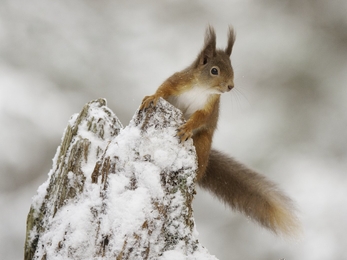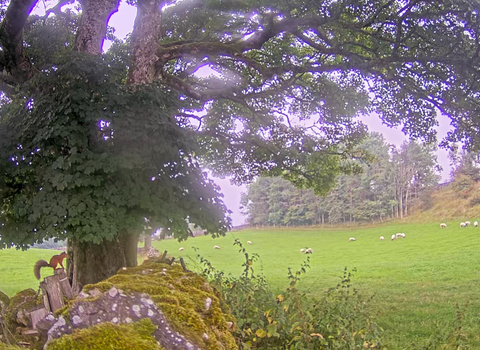
Red squirrel (Sciurus vulgaris) in pine forest, Glenfeshie, Scotland © Peter Cairns/2020VISION
Red squirrel
Scientific name: Sciurus vulgaris
A great way to catch a glimpse of a red squirrel is to watch our red squirrel cam.
Red squirrels are native to the UK but are a lot rarer than their grey cousins. They live in a few special places across the UK thanks to reintroduction projects.
Species information
Category
Statistics
Length: 18-24cm
Tail: 17-18cm
Weight: 100-350g
Average lifespan: 6 years
Conservation status
Protected in the UK under the Wildlife and Countryside Act, 1981. Priority Species under the UK Post-2010 Biodiversity Framework.
When to see
January to December
About
Native red squirrels are a lot rarer in the UK than their American cousins, grey squirrels. Usually found in coniferous woodland, they like to feast on hazelnuts by cracking the shell in half. If you’re lucky you may also find pine cones that have been nibbled, leaving what looks like an apple core behind!
Red squirrels make a rough nest called a ‘drey’ out of twigs, leaves and strips of bark high up in the tree canopy. Males can be seen chasing females through the trees, leaping across branches and spiralling up tree trunks.
How to identify
The red squirrel has a reddish-brown coat and pale underside. It has a characteristically bushy tail. It is distinguished from the grey squirrel by its smaller size, red fur and distinctive, large ear tufts.
Squirrel pox
The squirrel pox virus has decimated red squirrels in Cumbria. Surveys show conservation work by volunteers has kept red squirrel numbers stable across the north of England since 2012.
Saving our native red squirrel is relentless and long term, can you help? Please click here to join others who are already supporting our work for Cumbria's wildlife & wildplaces including our red squirrel conservation work
The non-native grey squirrel was introduced to England in the late 1870s from America and is the primary cause of decline of the red squirrel. It does so by out-competing red squirrels for food in deciduous and mixed woodlands and by transmitting a disease ‘squirrel pox’, the squirrel Parapoxvirus, which is lethal to red squirrels.
If you see a red squirrel, please inform Red Squirrels Northern England. Your sightings are very valuable in monitoring their locations.
Distribution
Found in Scotland, the Lake District and Northumberland; isolated, remnant populations further south in England and Wales, including Formby, Anglesey, Brownsea Island in Dorset, and the Isle of Wight.
Habitats
Did you know?
Red squirrels do not hibernate, but they do keep stores of food to see them through difficult times when fresh food is not available. In their favoured habitats of mixed broadleaf and coniferous woodland, they have a source of food all year-round as pine seeds are present over the winter months.




